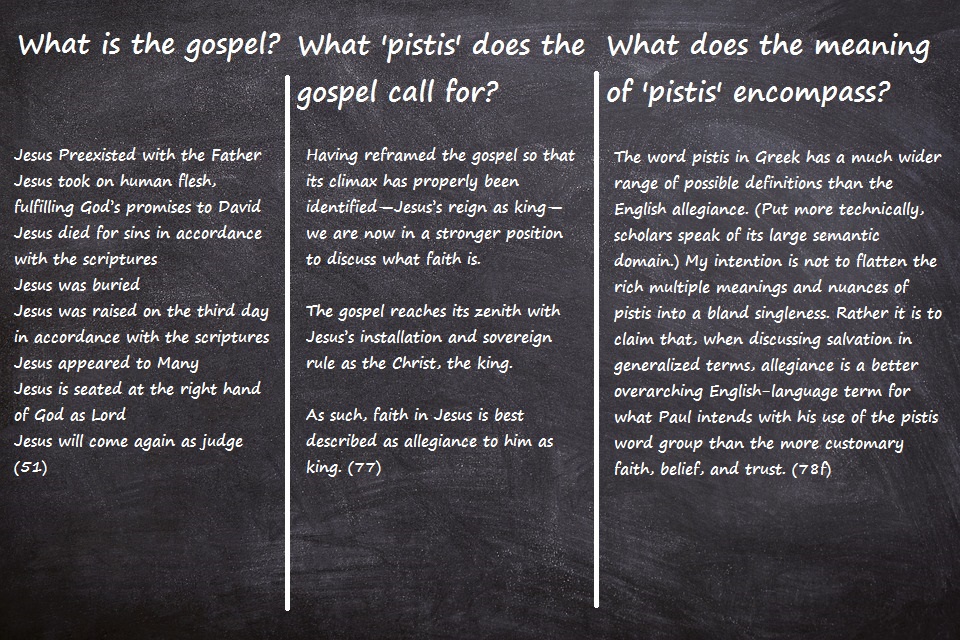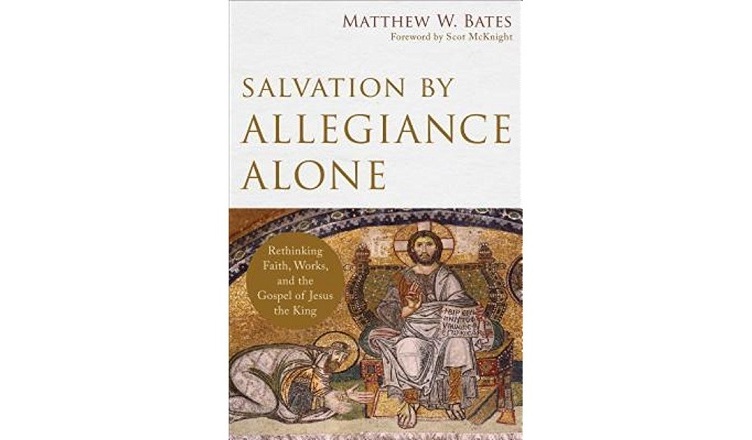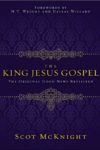 This book caused quite a stir when it was first published. It is about the pistis demanded by the gospel, and how this affects our understanding of salvation and works. It discusses all these topics with recent scholarship in mind.
This book caused quite a stir when it was first published. It is about the pistis demanded by the gospel, and how this affects our understanding of salvation and works. It discusses all these topics with recent scholarship in mind.
- Link: Amazon
- Length: 256
- Difficulty: Easy, Popular
- Topic: Gospel, Faith, Salvation, Works
- Audience: Mainstream Christians, Bible College Students
- Published: 2017
At the beginning of his book Bates mentions some of his intentions.
In this book I want to demonstrate that our contemporary Christian culture often comes prepackaged with functional ideas and operative definitions of belief, faith, works, salvation, heaven, and the gospel that in various ways truncate and distort the full message of the good news about Jesus the Messiah that is proclaimed in the Bible. (2)
Bates answer is that we understand salvation to be by allegiance alone.
In my opinion this is the book of the year. A must read. The book is recommended by Scot McKnight, Michael F. Bird, Michael J. Gorman, Gary Anderson and Joshua Jipp, so don’t just take my word for it. Read it!
This post is one of my book reviews.
Contents
Main points
Introduction
Having grown up in the reformed tradition and spent his doctorate years in a Catholic seminary Bates has a heart for unity and hopes this book will help Roman Catholics and Protestants come closer together.
He attempts to do this by proposing we conduct surgery on our definition of ‘faith’ [pistis] and the way we understand its relationship to the gospel and salvation.
The best corrective is that “faith” and “belief,” insofar as they serve as overarching terms to describe what brings about eternal salvation, should be excised from Christian discourse.
That is, English-speaking Christian leaders should entirely cease to speak of “salvation by faith” or of “faith in Jesus” or “believing in Christ” when summarizing Christian salvation. For the sake of the gospel we need to revise our vocabulary.
Although the Greek word pistis, the word that most often stands behind our English translations of “faith” or “belief” in the New Testament, can and does frequently involve regarding something as true or real, akin to how we might say “I have faith that God exists” or “my beliefs are different from yours,” the word pistis (and related terms) has a much broader range of meaning. This range includes ideas that aren’t usually associated in our contemporary culture with belief or faith, such as reliability, confidence, assurance, fidelity, faithfulness, commitment, and pledged loyalty. (3)
I’ve done a brief word study on faith, and as Douglas Campbell states the Greek word ‘pistis’ lacks precision.
Bates’ discussion is not unique to the Protestant – Roman Catholic debate. Jimmy Akins has written of this before following a different direction.
Instead of rendering pistis in english as ‘faith’ in key verses, he suggests we transplant this word with ‘allegiance’.
The needed surgery involves not just an excision of “faith” language but also a transplant. With regard to eternal salvation, rather than speaking of belief, trust, or faith in Jesus, we should speak instead of fidelity to Jesus as cosmic Lord or allegiance to Jesus the king.
This, of course, is not to say that the best way to translate every occurrence of pistis (and related terms) is always or even usually “allegiance.” Rather it is to say that allegiance is the best macro-term available to us that can describe what God requires from us for eternal salvation. It is the best term because it avoids unhelpful English-language associations that have become attached to “faith” and “belief,” as well as limitations in the “trust” idea, and at the same time it captures what is most vital for salvation—mental assent, sworn fidelity, and embodied loyalty. (4)
Over the next few chapters Bates will unpack his argument why it is a good idea substituting ‘allegiance’ for ‘faith’.
1. Faith Is Not
But first he argues what faith is not. Faith is not the opposite of evidence assessment. Bates opposes the idea that faith is contrary to the facts. Faith is not a leap in the dark. Bates opposes the idea faith is blind.
Here is the more controversial idea. Faith is not the opposite of works. This cuts to the grain of the grace/faith – works antithesis held by reformed doctrine. Bates discusses his upbringing in the reformed camp, which mimics what I’ve heard in countless sermons and talks over the years.
In retrospect the preached message I heard weekly growing up was subtly confused. No matter what passage of Scripture was being exposited, regardless of the liturgical season (my church was not exactly into following the ecclesial calendar), despite whatever contemporary political or societal affairs might be pressing, virtually every sermon had the same conclusion—a presentation of “the gospel” and an invitation “to accept Jesus into your heart.” Now, do not misunderstand: I think the gospel should be preached and invitations to follow Jesus need to be extended—urgently so. (20)
Those who understand how ministers create their sermons will have an understanding of why this is so. At the end of the day most ministers want their understanding of the gospel to shape every one of their sermons and bible studies. Their interpretation of the whole bible is coloured by their understanding of the gospel.
However, invariably the good news was presented in its classic “Romans Road” form and accompanied by a stern warning. That is, the gospel was given as follows:
- we are all perniciously bent on trying to earn our salvation by doing good deeds;
- yet all have sinned and fallen short of the glory of God—and that includes you;
- but the good news is that Jesus died for your sins;
- so if you will just believe this and pray along with me, then the free gift of eternal life is yours today.
And now the warning: the only thing that you must not under any circumstances do is believe that you can earn your salvation through good works, for this was the mistake of many Jews in Paul’s day and is still the error of Catholics today. (20)
This is the basic soterian gospel. (I’ve blogged on what the apostolic gospel is here). He then goes on to describe what I hear often from the reformed camp regarding good works.
Within this version of the gospel, which involves several dangerous distortions, good works end up playing the confusing dual role of friend and foe.
Good works are “friend” because they are believed to flow from the more primal response of belief and are evidence of genuine faith. In this way, it is still possible for those who adhere to this system to affirm James 2:26, “faith without deeds is dead,” because good works are felt to emerge spontaneously from the wellspring of faith.
Yet good works are “foe” because they can all too easily lure us, seduce us, become our false security blanket, causing us to rely on ourselves for our own salvation—and then, so it is presumed, we stumble (cf. Rom. 9:30–33). We must instead ever and always just trust, avoiding the seduction of seeking to earn God’s favor through moral or religious performance.
In this way faith and works are pitted against one another as opposite paths to salvation, one that is successful (faith) and one that fails (works). (20)
Consequently in my opinion a protestant will happily affirm Eph 2.10, but rarely if ever instruct their audiences to do good works (e.g. Tit 3.8,14) to receive eternal life (e.g. Gal 6.6-10).
Bates argues as well faith is not an “it’s all good” attitude. That is if you have faith, everything will work out well for you (prosperity gospel). And faith cannot not be reducible to intellectual assent, which is dead faith.
2. Loyalty and the Full Gospel
In this chapter Bates critiques the standard soterian gospel used by many reformed today. The gospel that narrowly focuses on Jesus’ death and forgiveness. He does not deny this is part of the gospel message, but he says to leave the gospel at this is to truncate the gospel.
He then moves to outline his understanding of the gospel. What I also agree is the biblical and apostolic gospel.
Anticipating my conclusions, the gospel is the power-releasing story of Jesus’s life, death for sins, resurrection, and installation as king, but that story only makes sense in the wider framework of the stories of Israel and creation.
The gospel is not in the first instance a story about heaven, hell, making a decision, raising your hand after praying a certain prayer, justification by faith alone, trusting that Jesus’s righteousness is sufficient, or any putative human tendencies toward self-salvation through good works.4 It is, in the final analysis, most succinctly good news about the enthronement of Jesus the atoning king as he brings these wider stories to a climax. (30)
Note the overlying framework – the stories of creation and Israel. Note he says the gospel is power releasing, that is it is transforming. Note he says the gospel is a story of Jesus’ life, death, resurrection and installation as king. Note he mentions the saving benefits of this story.
This is the gospel defined and proclaimed by Tom Wright, John Dickson, Scot McKnight and Michael Bird.
Bates goes into detail describing Jesus’ incarnation and enthronement. The V Pattern, Jesus goes down to earth, then he ascends to heaven in glory.
He argues this is the Christ story which was transmitted by the apostles which they all agreed upon was the gospel message.
He says is the gospel’s primary intention is to proclaim Jesus is Lord, then the right response is allegiance [pistis].
Using this as a foil he unpacks his interpretation of Rom 1.16-17 where he substitutes allegiance for faith.
For I am not ashamed of the gospel, for it is the power of God for salvation for everyone who gives allegiance to Jesus as the Christ [believes], to the Jew first and also to the Greek. For in the gospel the righteousness of God is revealed by means of Jesus’ allegiance to God; this righteousness becomes ours through our allegiance to Jesus the king. For both Jesus and us, all of this accords with the prophetic word, “But the righteous one shall live by allegiance” (His rendering, Rom 1.16-17) (44)
The verses have drawn a number of interpretations over the last two thousand years. This is one of them. I agree with what he is trying to say, but I will sit on the fence whether this is what Paul meant.
3. Jesus Proclaims the Gospel
In this chapter Bates spends more time on the gospel. This time what Jesus and his disciples preached as the gospel in the Gospels.
First he looks at Jesus as a Gospel preacher and the titles of the four Gospels.
The earliest Christians spoke about the story of the life, death, and resurrection of Jesus as one thing, one story, one message of “good news,” while acknowledging that this one message was attested by different tellers of that single story—Matthew, Mark, Luke, and John.
So the title most frequently evidenced in ancient copies of the earliest Gospel is The Gospel according to Mark. And this title equates not to the Gospel-type of literature written by Mark but rather to the version of the singular good news attested by Mark. The same can be said with regard to the ancient titles of Matthew, Luke, and John.
This reinforces the basic point: the gospel proper is not in the first instance a story about human need for salvation but a story about Jesus’s career, a career that culminates in his attainment of heavenly authority. The gospel story integrally involves Jesus’s death for sins, but that is only part of the story, and the gospel narrative draws our eyes above all to Jesus’s kingship. (51)
He notices that Jesus proclaims the Gospel in the Gospels and notes specifically what he proclaimed. My series on what is the gospel agrees with his assessment. Here are some passages as food for thought.
14 Now after John was arrested, Jesus came into Galilee, proclaiming the gospel of God, 15 and saying, “The time is fulfilled, and the kingdom of God is at hand; repent and believe in the gospel.” (Mk 1.14-15)
23 And he went throughout all Galilee, teaching in their synagogues and proclaiming the gospel of the kingdom and healing every disease and every affliction among the people. 24 So his fame spread throughout all Syria, and they brought him all the sick, those afflicted with various diseases and pains, those oppressed by demons, those having seizures, and paralytics, and he healed them. 25 And great crowds followed him from Galilee and the Decapolis, and from Jerusalem and Judea, and from beyond the Jordan. (Mt 4.23-25)
12 But when they believed Philip as he preached good news about the kingdom of God and the name of Jesus Christ, they were baptized, both men and women. 13 Even Simon himself believed, and after being baptized he continued with Philip. And seeing signs and great miracles performed, he was amazed. 14 Now when the apostles at Jerusalem heard that Samaria had received the word of God, they sent to them Peter and John, 15 who came down and prayed for them that they might receive the Holy Spirit, (Acts 8.12-15)
He argues for this basic outline of the gospel:
- Jesus Preexisted with the Father
- Jesus took on human flesh, fulfilling God’s promises to David
- Jesus died for sins in accordance with the scriptures
- Jesus was buried
- Jesus was raised on the third day in accordance with the scriptures
- Jesus appeared to Many
- Jesus is seated at the right hand of God as Lord
- Jesus will come again as judge (51)
I’m in complete agreement with Bates on the gospel.
4. Faith as Allegiance
Bates then highlights that if the chief intention of the gospel message is to proclaim Jesus as the Christ and Lord, then faith should logically be understood in terms of allegiance or loyalty to his as King. Through this chapter he gives a number of alternative scripture renderings with allegiance substituted for faith.
He considers the biblical evidence for allegiance in the New Testament and in Paul’s letters. Here are some passages as food for thought.
30 Now Jesus did many other signs in the presence of the disciples, which are not written in this book; 31 but these are written so that you may believe that Jesus is the Christ, the Son of God, and that by believing you may have life in his name. (Jn 20.30-31)
17 Now when they had passed through Amphipolis and Apollonia, they came to Thessalonica, where there was a synagogue of the Jews. 2 And Paul went in, has was his custom, and on three Sabbath days he reasoned with them from the Scriptures, 3 explaining and proving that it was necessary for the Christ to suffer and to rise from the dead, and saying, “This Jesus, whom I proclaim to you, is the Christ.” 4 And some of them were persuaded and joined Paul and Silas, as did a great many of the devout Greeks and not a few of the leading women. … 6 And when they could not find them, they dragged Jason and some of the brothers before the city authorities, shouting, “These men who have turned the world upside down have come here also, 7 and Jason has received them, and they are all acting against the decrees of Caesar, saying that there is another king, Jesus.” 8 And the people and the city authorities were disturbed when they heard these things. (Acts 17.1-8)
1 Paul, a servant of Christ Jesus, called to be an apostle, set apart for the gospel of God, 2 which he promised beforehand through his prophets in the holy Scriptures, 3 concerning his Son, who was descended from David according to the flesh 4 and was declared to be the Son of God in power according to the Spirit of holiness by his resurrection from the dead, Jesus Christ our Lord, 5 through whom we have received grace and apostleship to bring about the obedience of faith for the sake of his name among all the nations, 6 including you who are called to belong to Jesus Christ (Rom 1.1-6)
8 But what does it say? “The word is near you, in your mouth and in your heart” (that is, the word of faith that we proclaim); 9 because, if you confess with your mouth that Jesus is Lord and believe in your heart that God raised him from the dead, you will be saved. 10 For with the heart one believes and is justified, and with the mouth one confesses and is saved. 11 For the Scripture says, “Everyone who believes in him will not be put to shame.” 12 For there is no distinction between Jew and Greek; for the same Lord is Lord of all, bestowing his riches on all who call on him. 13 For “everyone who calls on the name of the Lord will be saved.” (Rom 10.8-13)
He then goes into a little detail explaining the relationship between faith as allegiance and faith as trust in God’s promises. He says trust can be absorbed in the bigger notion of allegiance. The two concepts are not opposed to one another.
I have made the claim that pistis, which has traditionally been translated as “faith” in Paul’s Letters, is better understood as allegiance when speaking of how the gospel of Jesus unleashes God’s power for salvation. This is not to say that all occurrences of the noun pistis (and associated words) should be uniformly translated this way—in fact, they manifestly should not. There is no one-to-one correspondence between pistis and allegiance even though these terms overlap appreciably. The word pistis in Greek has a much wider range of possible definitions than the English allegiance. (Put more technically, scholars speak of its large semantic domain.)1 My intention is not to flatten the rich multiple meanings and nuances of pistis into a bland singleness. Rather it is to claim that, when discussing salvation in generalized terms, allegiance is a better overarching English-language term for what Paul intends with his use of the pistis word group than the more customary faith, belief, and trust. (78f)
He then outlines his understanding of the dimensions of allegiance. Allegiance includes the notions of:
- Intellectual agreement,
- Confession of Loyalty, and
- Embodied Fidelity
The last one, embodied fidelity, is a point of tension between Protestants and Catholics. That pistis itself could be understood this way is not too much of a stress because pistis can be rendered as faithfulness.
But here again we ask the thorny question, ‘Are works necessary for salvation?’. I have answered this question in my page on Future Judgment and Salvation and again I find myself in agreement with Bates.
Bates here includes the importance of works – as embodied fidelity – as necessary for salvation. Here are some passages which suggest ‘faith’ can be understood as something people do with reference to Jesus.
2 And many were gathered together, so that there was no more room, not even at the door. And he was preaching the word to them. 3 And they came, bringing to him a paralytic carried by four men. 4 And when they could not get near him because of the crowd, they removed the roof above him, and when they had made an opening, they let down the bed on which the paralytic lay. 5 And when Jesus saw their faith, he said to the paralytic, “Son, your sins are forgiven.” … 10 But that you may know that the Son of Man has authority on earth to forgive sins” (Mk 2.2-5, 10)
8 First, I thank my God through Jesus Christ for all of you, because your faith is proclaimed in all the world. (Rom 1.8)
15 For this reason, because I have heard of your faith in the Lord Jesus and your love toward all the saints, (Eph 1.15)
Okay, so if I flipped this around to a judgment by works passage,
6 He will render to each one according to his works: 7 to those who by patience in well-doing seek for glory and honor and immortality, he will give eternal life (Rom 2.6-7)
Do you think it appropriate to call ‘patience in well doing and seeking for glory, honour and immortality’ embodied allegiance to Jesus as King? I think yes, because it affirms that salvation is only in Christ.
Bates argues the gospel is meant to bring about embodied allegiance to Jesus the king.
There is a better solution. If we recognize that the climax of the gospel is Jesus’s enthronement and that pistis is predominately allegiance, then Paul’s point is lucid: the gospel is purposed toward bringing about the practical obedience characteristic of allegiance to a king—what I have termed enacted allegiance. The gospel and Paul’s mission are aimed at bringing about embodied allegiance to Jesus the king among the nations. (85)
Bates’ argument so far looks like this;

5. Questions about Allegiance Alone
In this chapter Bates responds to a few anticipated questions. I’ll comment on some of the more significant.
Grace and Allegiance Alone?
Bates is helpfully up to date on the recent work on Paul’s understanding of grace.

The matter, I submit, is essentially no different if we understand pistis as allegiance to Jesus, the cosmic king. We are still saved by grace through pistis; salvation comes from outside ourselves as the Christ gift. Yet we must respond to that gift by giving allegiance to Jesus as Lord. The offer of salvation is free, but it absolutely does come with strings attached. Obedient loyalty to the king is required as a condition of acceptance.
John Barclay shows that “grace” (charis) has been susceptible to six differentiable meanings for those who have interpreted Paul’s Letters:
- (1) superabundance—the size of the gift;
- (2) singularity—the pure benevolence of the gift;
- (3) priority—giving at the ideal advance time;
- (4) incongruity—lack of merit in the recipient;
- (5) efficacy—the ability of the gift to achieve its intended purposes;
- (6) noncircularity—the absence of obligation to reciprocate by giving a gift in return.
Paul himself does not necessarily “perfect,” or take to its extreme limit, each one of these nuances of grace. In fact, he does not even include all of them in his own understanding of grace, as noncircularity in particular is alien to Paul. In other words, Barclay has convincingly demonstrated that it is a misunderstanding of grace (gift) in antiquity and in Paul’s Letters to suggest that grace could not truly be grace if it requires obedience as an obligatory return. (104)
I have reviewed Barclays book here. Bates highlights that our understanding of God’s grace in Christ should also contain notions of efficacy and reciprocity. My thoughts exactly.
He then discusses Irresistible Grace and Free Will, before moving onto another significant question.
Works and Allegiance Alone?
He discusses whether it is right to say people’s works as the basis for eternal judgment. Again see my page on Future Judgment and Salvation. I found this following statement quite helpful considering the debate.
In other words, a typical solution is to suggest that faith, the act of decisive trust or belief, comes first, and then good works naturally flow as a secondary effect, like a river from a spring. As Thomas Schreiner puts it, “Works are the necessary evidence and fruit of a right relation with God. They demonstrate, although imperfectly, that one is truly trusting in Jesus Christ.” Yet there are problems with this works-are-not-the-basis and works-are-the-necessary-evidence approach of Schreiner, Piper, and others.
There is a simpler solution. Might it not be better to affirm that when Paul speaks of salvation by pistis in Jesus the Christ, not by works, that he speaks of allegiance to Jesus as the sovereign king?
That is to say, we really are eternally judged, just as Paul indicates, in part on the basis of our works, but these works are part of pistis as embodied allegiance or enacted loyalty. Pistis is not the polar opposite of works; rather pistis as ongoing allegiance is the fundamental framework into which works must fit as part of our salvation. (109, italics mine)
Bates singles out Schreiner and Piper 2-3 times in his book. It’s little wonder Schreiner was called upon to write a review of this book in TGC.
Bates then moves on to allegiance and the Law with the New Perspective on Paul and works of law. His position is reasonably eirenic. While I differed from him here, I found his interpretation helpful in gaining a mediating position between the NPP and OPP.
He then discusses the role of obedience, obeying the Law of Moses in salvation and the flesh – spirit language in Paul.
Near the end he talks about struggling with sin, imperfect allegiance and describes sin as treason against King Jesus. This idea is not uncommon considering sin is often described as rebellion against God.
Lastly he answered how much allegiance is required to be saved.
6. Resurrection into New Creation
Chapter six and seven prepare us for the discussion in chapter eight on justification.
In chapter six, Bates outlines what the bible says about the end times. He discusses the new Heaven and the new Earth. Contrasting the garden of Eden and the New heaven and earth he speaks about the divine presence which left, but is predicted to return and join the people of God. He uses the lense of the tabernacle, the temple and the incarnation.
How, then, can we best describe the biblical vision of the final horizon of salvation? Contrary to widespread cultural assumptions in the Western world and much popular Christian teaching, the final goal of salvation in the Christian story is not the individual soul reaching heaven. On the contrary, heaven is discussed very little in the Bible and is best regarded as a temporary abode with God in anticipation of the more glorious next act in the divine drama. God will radically recraft the present cosmic order, refining everything. The transformation will be so dramatic that when he sees the vision, John is compelled to exclaim, “I saw a new heaven and a new earth, for the first heaven and the first earth departed” (Rev. 21:1)! (143)
7. Restoring the Idol of God
This chapter gave an interesting twist on what it means to be made in the image of God. Bates begins explaining what it means to be created in God’s image.
So the text urges the conclusion that humans are created in God’s image so that they can undertake the fundamental task of ruling for God. The purpose of bearing the image is so that the created order can receive proper governance, so that humans can bring the wise rule of God in a tangible fashion to creation. This is why Adam (and eventually Eve) is placed in the garden to “work/serve” it (from ʿabad, which relates especially to the word for servant or slave) and to “keep” it (from shamar, which pertains to superintendence: watching, guarding, and protecting). The prolifically wild fruitfulness of the created order needs to be actively marshaled; it needs to be directed, tamed, and tended so that humans, animals, plants, and the non-living portions of creation can mutually benefit. This, among other reasons, is also why humans are instructed to be fruitful and to multiply: if the created order is ever to reach its maximum life-sustaining potential, it is necessary that many humans come into being and take up their God-given task of active service and governance. (147)
I found this quite helpful and I know of a couple of friends who would warn to this understanding of being made in God’s image.
Bates then says we are created in the Idol (Image) of God. Image and Idol are used interchangeably. He outlines the purpose of Idols/Images.
From the above, we can conclude that what it meant to be in the image/idol of a god in the ancient Near East was not about having a singularly unique capacity, such as reason or a soul that might separate humans from the animals; rather the image served as a holistic manifestation of the divine presence to those who might encounter the deity in and through the image. …
Thus, applying these insights to humans as created in the image/idol of the God of Israel, when other creatures encounter humans, they are in the presence of God via God’s idol. God has imbued his human-idols with his active presence. God breathes his breath/spirit (ruach) into the nostrils of the clay figure Adam, and he becomes a living nepesh (“person” or, traditionally, “soul”) (Gen. 2:7). The idol of God, Adamic humanity, that has been placed in the garden-temple of Eden has in this manner been pervaded by the divine breath/spirit. (150)
He builds on this discussion asking and answering why were images forbidden by God? He say this is part of what happened with the fall. Humanity began to create forbidden Images and became defaced Image-Bearers.
From this point he discusses salvation as human transformation and proper worship. Jesus is the complete and original Image of God. We are renewed as we become more and more like him.
8. Justification and Allegiance Alone
Bates begins this penultimate chapter discussing Union in Christ and the Order of Salvation. He notes several scholars who are now understanding salvation as inseparable from union in Christ.
His whole approach to salvation is helpfully structured from a narrative understanding of biblical theology.
In contradistinction, biblical scholars when systematizing (that is, when doing “biblical theology”) tend to describe how the various terms such as “election” function in ancient texts while resisting the tendency to treat these terms as overarching, reified categories or as discrete stages in an “order of salvation” except inasmuch as they seem to function consistently as such for specific ancient thinkers. So it is crucial to allow the narrative flow of Scripture, considered historically, to control the categories and meanings if we are to understand the Bible’s vision of salvation. (170, bold mine)
Bates notes the difficulties associated with the order of salvation. My review of Hoekema’s Saved by Grace revealed several positions in the reformed camp and he thought it best to think of many of the concepts associated with initial salvation to happen instantaneously.
And commenting on Rom 8.29-30
29 For those whom he foreknew he also predestined to be conformed to the image of his Son, in order that he might be the firstborn among many brothers. 30 And those whom he predestined he also called, and those whom he called he also justified, and those whom he justified he also glorified. (Rom 8.29-30)
He says;
But the more important point here is that although Romans 8:29–30 gives rock-solid promises of eternal security for the collective people of God, these promises only lend assurance to the individual who remains “in the Messiah”—that is, within the body or group. Since Paul has the collective in view here, his words about foreknowledge, predestination, calling, justification, and glorification apply to the company as a whole, but he does not speak to the security of individual membership in the company.
Contrary to the conclusion of many systematic theologians, Paul says nothing here directly about the election of specific individuals to eternal life (or condemnation) or about the inevitability of final salvation for any such chosen individuals.
Notice further that Paul does not say, “Those whom he justified he also will glorify,” but rather “those whom he justified he also glorified” (Rom. 8:30). That is, just like “justified,” the verb “glorified” is in the aorist indicative, the verbal form in Greek that is most often used to represent past events in a holistic fashion. In other words, glorification is not spoken of as future here, for glorification (just like justification) has a past, present, and future dimension. So, Paul is probably not delineating a progressive order of salvation designed to climax with future glory. (173)
Highlighting his corporate understanding of these processes. Bates’ view does not deny individual election in other passages, but he does rule it out in Rom 8.29-30.
Note also he notes rightly the aorist tense for foreknowledge, predestination, calling, justification, and glorification. For existing believers, these in some sense, have already happened.

Drawing heavily upon Michael Bird in the Saving Righteousness of God, Bates also builds into his understanding of Justification, Christ’s resurrection.
Bates devotes a fair amount of space to discussing the righteousness of God. See my review of NT Wright’s, What Saint Paul Really Said for various interpretations. He looks at the scriptural evidence, imputed righteousness (Reformed), infused righteousness (Catholic) and lastly incorporated righteousness. This last one is adovcated by Bird as part of his understanding of our union in Christ.
For Paul, then, the righteousness of God is God’s resurrection-effecting verdict that Jesus the wrath-bearing, sin-atoning, allegiant king is alone righteous—a verdict that all who are united to Jesus the representative king share. This death-unto-resurrection-life verdict is made effective for us as an unmerited gift when we are united by allegiance alone to the death and resurrection of Jesus the king via the Holy Spirit.26 The result is that “in the Messiah-king” we “become the righteousness of God”; that is, we become the family that has died with the Christ and that has been reconstituted “in him” by God’s declarative (innocence-creating) yet transformative (resurrection-effecting) verdict. (180)
I side more with Wright here, though I note they are similar.
For me ‘righteousness’ is normally understood as an action. In this case I argue God’s righteousness is what he is has done or is doing in the world. In the OT the term is normally associated with his kingship, but occasionally with reference to the covenant.
In Paul, the righteousness of God is frequently mentioned with reference to the gospel. That is the story of Jesus’ life, death, resurrection and enthronement. Here the righteousness of God, is his action in Jesus Christ, through his life, death, resurrection and enthronement, which brings about the salvation of all who believe. God acts in righteousness in accordance with his OT promises and prophecies which bear witness to what he will do / has done in the gospel. In this sense God is being faithful, which is why I agree with Wright that God’s righteousness is his covenant faithfulness.
Likewise I disagree with Bates on 2 Cor 5.21 (my post on this passage here). Paul uses the ‘we’ and the ‘us’ pronouns to refer to himself and the other apostles in their [gospel] ministry of reconciliation, in contrast to the ‘you’ Corinthians. Bates has made the typical interpretative mistake of assuming the text is always about ourselves (See Stendahl and Richards).
Bates concludes with this point building in his understanding of faith allegiance to Jesus the King.
In bringing this chapter to a conclusion, we may ask whether there is a phrase that can capture the valid insights in imputed and infused righteousness, minimize inadequacies, and stay near to the Bible’s own idiom. In answer, rather than imputed or infused righteousness, it is better to speak of in-the-Messiah righteousness or incorporated righteousness. In-the-Messiah or incorporated righteousness can be defined as the saving perfect righteousness of Jesus the Christ that is counted entirely ours when we join the Spirit-filled body that is already united to the righteous one, Christ the kingly head. That is, this alien righteousness, this righteous standing that properly belongs to Jesus alone, becomes ours derivatively when we give allegiance to Jesus as the sovereign king, at which moment the life-giving Spirit that already envelops the allegiance-yielding community also enters into us. At the moment of allegiance-generated, Spirit-enabled union, the individual is born again, is declared and truly is fully righteous in God’s sight, and can properly be described as having eternal life (189)
Overall I found this chapter too focussed on systematic theology, rather the what ‘justified’ and its cognates means in specific texts. E.g. Romans 1-4 and Galatians 2-3. That is, he largely fails to bring it down to earth and show, from scripture, how this can be demonstrated in Paul’s writings. Bird fails here too in my opinion.
9. Practicing Allegiance
The final chapter is a practical outworking of the implications for his whole argument.
The first section of the chapter goes over his arguments concerning what the content of the gospel message is, the response it seeks and how this should shape our evangelism. The gospel foregrounds Jesus as King. The gospel is a story about Jesus, not a procedure to garner decisions. Unhelpfully the gospel can be reduced, at which point it can no longer be called the gospel. Bates argues the entire Gospel story is necessary. Bates says the power of the gospel brings about a holistic transformation. He warns us of the dangers of false assurance and the necessity for perseverance and good works. He calls us to confess our allegiance to Christ publicly.
Bates encourages his audiences to confess the gospel and their allegiance to Christ corporately in their churches using the Apostles’ Creed.
The Apostles’ Creed is not merely a convenient summary of Christian beliefs. It is a concise presentation of the allegiance-demanding gospel. In this study we discovered that the gospel in earliest Christianity was an eight-part story that encompasses Jesus’s entire life, from his preexistence with the Father until his return in glory. Although it may be necessary to review chapter 2 to see why fully, notice that all of these elements (except #6, which is assumed) are in fact present in the Apostles’ Creed: (210)
| Apostles’ Creed | Gospel Outline |
| I believe in God, the Father Almighty, Creator of heaven and earth; I believe in Jesus Christ, His only Son, our Lord: | (1) Jesus Preexisted with the Father |
| Who was conceived by the Holy Spirit, born of the Virgin Mary; | (2) Jesus took on human flesh, fulfilling God’s promises to David |
| suffered under Pontius Pilate, was crucified, died | (3) Jesus died for sins in accordance with the scriptures |
| and was buried. He descended into hell; | (4) Jesus was buried |
| the third day He rose again from the dead; | (5) Jesus was raised on the third day in accordance with the scriptures |
| (6) Jesus appeared to Many | |
| He ascended into heaven, is seated at the right hand of God the Father Almighty; | (7) Jesus is seated at the right hand of God as Lord |
| from thence He shall come to judge the living and the dead. | (8) Jesus will come again as judge |
| I believe in the Holy Spirit, the Holy Catholic Church, the communion of Saints, the forgiveness of sins, the resurrection of the body, and life everlasting. Amen. |
When a person says the Apostles’ Creed, he or she is restating the gospel of the earliest church in outline form—the story of how Jesus came to be the cosmic Lord. As such, the Apostles’ Creed could easily be used by churches as a trinitarian pledge of allegiance to Jesus the king. (210)
I thought this was wonderful.
Recommendation
While Bates’ book at times does mention some complex debates about Paul, it is short and easy to read. I think it’s readily absorbable for wider Christian reading. I really liked how he tried to meet Roman Catholics and Protestants in the middle. Both streams can read this book.
I think his understanding of the gospel and its consequent demand that hearers give their allegiance to him as King is spot on biblically. One hundred over one hundred. This is the best part of his book and why you should read it.
Even though I agree the primary content of saving faith is that it confesses Jesus is the risen Christ, I still find it difficult to replace faith with allegiance. His arguments relating to striking the ‘faith’ word from our vocabularies I believe will meet stubborn refusal. The word ‘faith’ is so deeply entrenched into our biblical framework that his argument will always be an uphill battle.
His argument that the notion of allegiance contains the idea of embodied allegiance even more so, especially with protestants who want to keep future judgment and salvation works free.
Nonetheless, note I am quite comfortable with saying embodied allegiance is necessary for salvation. I think this does shed some helpful light on the judgment according to works and several future salvation texts and perhaps he should have spent a bit more space on this topic in his book to help people see how embodied allegiance can better explain the scriptures.
Copyright © Joshua Washington and thescripturesays, 2017. All Rights Reserved.









